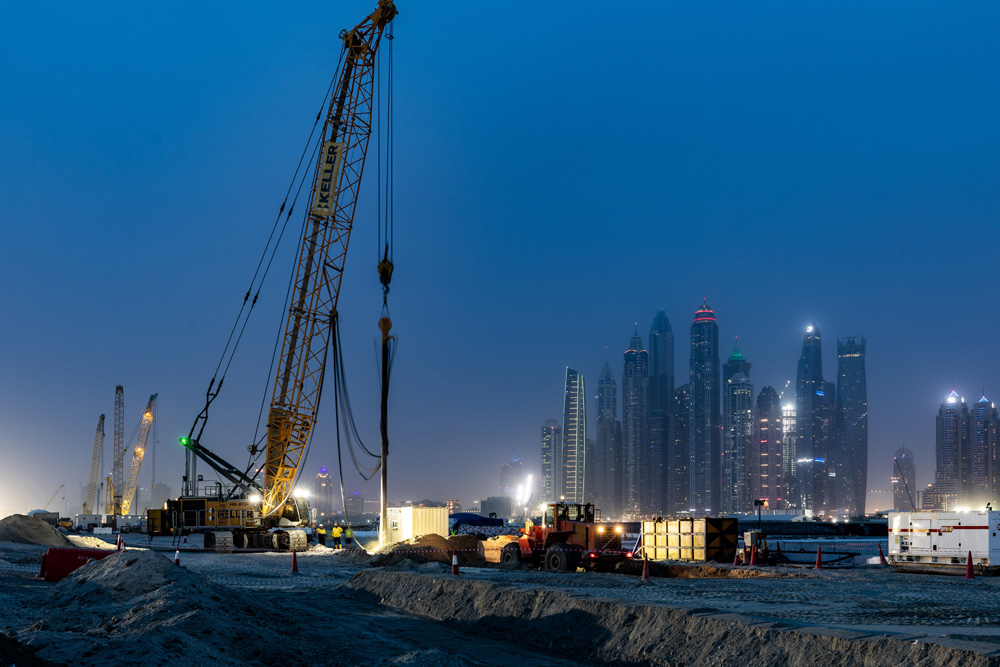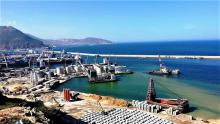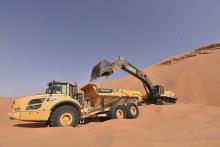
When hundreds of Chinese workers returned home from the region to celebrate the Lunar New Year in January 2020, they had little or no inkling that the coronavirus would shatter their plans of returning to their respective workplaces in the Arab world where they were involved in several infrastructure projects.
As the pandemic assumed alarming proportions in the region, several countries imposed a travel ban and enforced lockdowns to avoid spreading the virus. Still, coronavirus took a heavy toll on human life and most of the projects were either cancelled or put on hold till the situation returned to normalcy.
However, some of the countries have started opening up and precautions are in place to contain the virus.
In the last few years, China has been making its presence felt among the Arab countries by building close economic and strategic ties with key markets and countries in the region.
According to China Customs Statistics (export-import), China-Middle Eastern countries’ trade volume increased to US$294.4 billion by 2019, up from US$227 billion in 2018, as both sides have cemented their cooperation in the fields of energy, trade, project contracting, and investment.
These countries are strategically important as they lie at the heart of China’s BRI. Many countries have set up bilateral investment funds with China to finance BRI-related projects. For instance, the UAE has established a $10 billion joint strategic investment fund between Abu Dhabi investment group, Mubadala, the China Development Bank and the Chinese State Administration of Foreign Exchange, according to leading data and analytics company GlobalData.
As of mid-2019, China had signed agreements with 21 MENA (Middle East, North Africa) countries, including 18 Arab League nations, on a joint BRI project. At a meeting of the China-Arab States Cooperation Forum (CASCF) in Beijing in 2018, China pledged $23 billion in loans and development aid to the region. The meeting identified the UAE’s Khalifa Port, Oman’s Duqm, Saudi Arabia’s Jizan, and Egypt’s Port Said and Ain Sokhna as key projects that China will develop in association with the BRI in the Middle East.
Chinese contractors are also involved in major infrastructure construction contracts in Qatar, including the $25 billion expansion plans for Hamad International Airport (HIA), which will deliver an expanded capacity of 53 million passengers by 2022 (compared with 34.5 million handled in 2018).
The scope of China’s interest in the Gulf region has increased in recent years from a limited focus on hydrocarbon trade to a multitude of investments in energy, industry, finance, transport, communications and other technology.
A report by the China Global Investment Tracker said that Beijing’s investments in the region stood at $93.3 billion in 2019. Most are in the energy sector ($52.8 billion), real estate ($18.4 billion), transport ($18.6 billion), and utilities ($5.9 billion). This is crucial for the region as most MENA countries are under pressure to diversify their economies and have been embarking on ambitious infrastructure and construction projects, GlobalData said.
Projects impacted
Speaking to media in June, China’s Foreign Affairs Ministry International Economic Affairs director, General Wang Xiaolong, confirmed that about 20% of projects under BRI were seriously affected by the pandemic while about 40% were adversely affected and a further 30%-40% were “somewhat affected”, as quoted in the Hong Kong-based South China Morning Post.
According to Wang, restrictions on travel and the flow of goods across borders, as well as local measures to combat COVID-19, were the main reasons for the impacts on projects. “As the situation improves, we have confidence that the projects will come back and the execution of them will speed up,” he added.
Reports also said that Egypt has postponed construction of a coal-fired power plant, Bangladesh has cancelled plans for a coal plant, Pakistan has asked Beijing for easier repayment terms on $30 billion-power projects and Tanzania is planning to cancel a port project.
Growing influence
Despite these hiccups, China’s influence in the region continues to grow even as COVID-19 disrupts supply chains. An example of its role in the region came on 26 April when Saudi Arabia’s National Unified Procurement Company (NUPCO) signed an agreement worth $265 million with China’s Beijing Genome Institute to expand COVID-19 testing capacity in the Kingdom.
As per the agreement, Beijing will provide 9 million COVID-19 test kits, 500 experts, specialists and technicians to ramp up testing in Saudi Arabia. Six large test laboratories will also be established including an inflatable mobile laboratory with a production capacity of 10,000 tests daily.
In the field of energy, Saudi Aramco awarded contracts for the four main packages that are part of its estimated Aramco’s $2 billion Aramco’s South Ghawar unconventional shale gas field development project.
The largest deal signed in April this year in the region was a $2.86 billion contract signed between China State Shipbuilding Corporation (CSSC), the world’s largest shipbuilder, and
Qatar Petroleum (QP) for the construction of LNG (liquified natural gas) tankers. The tankers will be built by Hudong-Zhonghua Shipbuilding at its unit in Shanghai. This contract is the first part of a huge order that could include more than 60 LNG carriers in total as QP has announced its plans to increase its LNG production capacity from the present 77 million tonnes per year to 126 million tonnes per year in the coming few years.
GlobalData’s Economist Yasmine Ghozzi said China’s overseas investment and construction saw a considerable shift in 2019 that could be explained by a drain of foreign exchange used to finance construction and investment since its BRI launch in 2013. It will continue to search for growth drivers globally and the Middle East presents vast opportunities to explore areas of cooperation in different industries to help the region accelerate its own development and industrialisation.
“In terms of infrastructure building and trade investment, the BRI will continue to focus on mega-project building, and the MENA region has an active pipeline for its 2030 vision,” she noted.
Even the nuclear power industry looks promising for the Chinese as Saudi Arabia, the UAE, and Egypt have plans to develop nuclear power industries. Although Russia has been the dominant player in the region when it comes to nuclear power investment, there is room for China to also play a crucial role.
A second area is aerospace satellite cooperation. As part of the “digital Silk Road”, satellites are a priority for China in the Middle East. China has already set its goal to install its BeiDou Navigation Satellite System in more Arab countries, where it will launch eight satellites over the skies of Arab countries for application in communication, navigation and meteorological remote-sensing services. Telecommunication companies in Bahrain, Egypt, Kuwait, Saudi Arabia and the UAE have all partnered with Huawei to build 5G networks, Yasmine Ghozzi said.
Temporary setback
Liebherr Group, which is one of the largest manufacturers of the construction machinery in the world, has been associated with several projects in the Middle East for many years. But like other companies, Liebherr too has been impacted due to the COVID-19 pandemic.
Liebherr (China) General Manager Patrick Schulz said that due to the outbreak of the pandemic, several projects have been delayed due to lockdowns and major challenges for the medical system in the respective countries.
“This, however, is considered only a temporary setback as there were no projects cancelled up to now. At the moment, we assume that COVID-19 may cause delays of approximately two to three months. Of course, that’s a current prognosis possibly changing as the pandemic is not over yet,” he said.
On returning to normalcy, he said: “Further situation mainly depends on the pandemic’s development in the Middle Eastern countries and the regulations the governments are forced to enact. Generally, it seems as if the Middle Eastern region puts high emphasis on tracking and testing instead of requesting complete lockdowns. That’s why we expect projects to be continued soon.”
Making inroads in Israel
In Israel, China has become the dominant force in the local construction industry and in November 2016 five Chinese construction giants won the government tenders to build residential housing in the country and to manage these projects as the company responsible for all of its the engineering and performance aspects.
In January 2017, Israel and China signed an agreement to bring 20,000 Chinese professional construction workers to Israel in the coming year. By March 2020, 3,500 Chinese workers had arrived and another 700 were commissioned by contractors and were expected to arrive soon. But 1800 workers remain in China.
Dr. Mordechai Chaziza, who is working as senior lecturer in the department of Politics and Governance and the division of Multi-disciplinary Studies in Social Science, Ashkelon Academic College in Israel, said that Beijing has repatriated citizens working in Iran due to the spread of the virus, a measure it could apply to any BRI host country in the Middle East severely afflicted with the spread of the coronavirus, and one which will bring other BRI projects to a halt.
“Most countries in the Middle East have placed entry restrictions on Chinese citizens or individuals travelling from China. The longer that Chinese workers are unable to return to projects overseas, the longer the BRI projects will languish incomplete, and some may be abandoned altogether,” he noted.
The coronavirus has also hampered China’s manufacturing supply chains, and BRI projects are predominantly reliant on Chinese, rather than local materials and supplies.

Currently, almost half of China’s oil imports are sourced from the Middle East, principally from the Persian Gulf. The pandemic has compromised the global supply chains that keep BRI projects moving forward, limiting the goods flowing out of China to the point that China ran a trade deficit during the first two months of this year.
China’s shuttered factories not only need workers to be released from quarantines to resume normal output, but also need restored supplies of raw materials, adequate stores of protective gear for workers, and active truckers and shipping ports to deliver their goods abroad, he said.
“The coronavirus has also disrupted the global shipping industry and slowed to the point that more tonnage of container ships was idled around the world in February than during the worst points of the 2008 financial crisis,” he averred.
On how soon these projects will be back in action, he said that it was still too early to predict and depended on many factors that are not necessarily controlled by the Chinese or local countries. The restrictive travel bans, port closures, cancelled flights, and blocked roads have prevented Chinese workers from returning to BRI worksites abroad, while the shutdown of Chinese factories that supply machinery and raw materials for BRI projects has hindered projects from moving forward.
These and other disruptions are causing delays, missed deadlines and have increased infrastructure costs that local economies will find difficult to absorb. “Nevertheless, COVID-19 will not be fatal to the implementation of BRI projects, but the disease’s fast and lethal spread will cause Middle East governments to rethink the risks attached to ever more integration and economic dependence on PRC’s (People’s Republic of China’s) infrastructure,” he added.










